中西方饮食文化差异(英语)
- 格式:ppt
- 大小:14.95 MB
- 文档页数:39
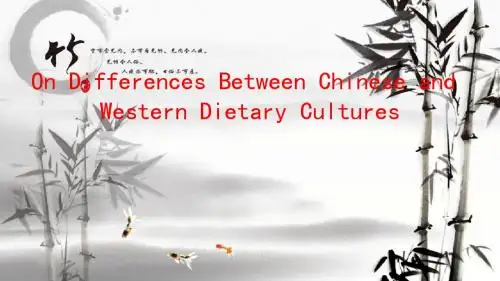
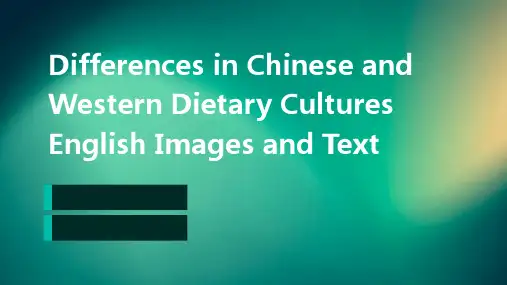
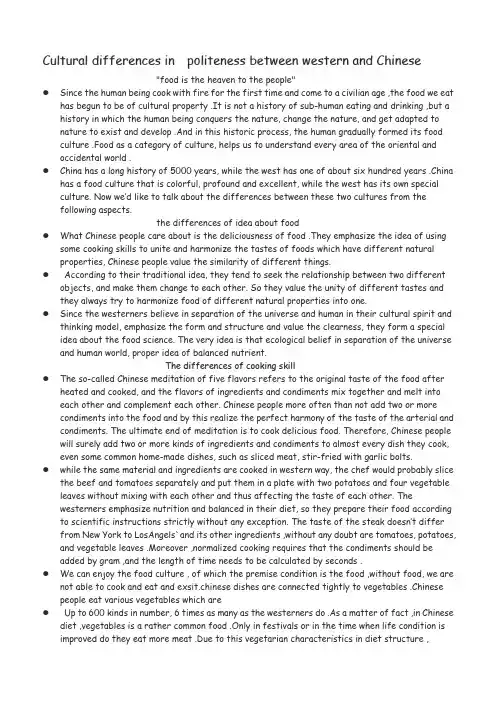
C u l t u r a l d i f f e r e n c e s i n p o l i t e n e s s b e t w e e n w e s t e r n a n d C h i n e s e"food is the heaven to the people"●Since the human being cook with fire for the first time and come to a civilian age ,the food we eathas begun to be of cultural property .It is not a history of sub-human eating and drinking ,but a history in which the human being conquers the nature, change the nature, and get adapted to nature to exist and develop .And in this historic process, the human gradually formed its food culture .Food as a category of culture, helps us to understand every area of the oriental and occidental world .●China has a long history of 5000 years, while the west has one of about six hundred years .Chinahas a food culture that is colorful, profound and excellent, while the west has its own special culture. Now we’d like to talk about the differences between these two cultures from thefollowing aspects.the differences of idea about food●What Chinese people care about is the deliciousness of food .They emphasize the idea of usingsome cooking skills to unite and harmonize the tastes of foods which have different natural properties, Chinese people value the similarity of different things.●According to their traditional idea, they tend to seek the relationship between two differentobjects, and make them change to each other. So they value the unity of different tastes and they always try to harmonize food of different natural properties into one.●Since the westerners believe in separation of the universe and human in their cultural spirit andthinking model, emphasize the form and structure and value the clearness, they form a special idea about the food science. The very idea is that ecological belief in separation of the universe and human world, proper idea of balanced nutrient.T h e d i f f e r e n c e s o f c o o k i n g s k i l l●The so-called Chinese meditation of five flavors refers to the original taste of the food afterheated and cooked, and the flavors of ingredients and condiments mix together and melt into each other and complement each other. Chinese people more often than not add two or more condiments into the food and by this realize the perfect harmony of the taste of the arterial and condiments. The ultimate end of meditation is to cook delicious food. Therefore, Chinese people will surely add two or more kinds of ingredients and condiments to almost every dish they cook, even some common home-made dishes, such as sliced meat, stir-fried with garlic bolts.●while the same material and ingredients are cooked in western way, the chef would probably slicethe beef and tomatoes separately and put them in a plate with two potatoes and four vegetable leaves without mixing with each other and thus affecting the taste of each other. Thewesterners emphasize nutrition and balanced in their diet, so they prepare their food according to scientific instructions strictly without any exception. The taste of the steak doesn’t differ from New York to LosAngels`and its other ingredients ,without any doubt are tomatoes, potatoes, and vegetable leaves .Moreover ,normalized cooking requires that the condiments should be added by gram ,and the length of time needs to be calculated by seconds .●We can enjoy the food culture , of which the premise condition is the food ,without food, we arenot able to cook and eat and exsit.chinese dishes are connected tightly to vegetables .Chinese people eat various vegetables which are●Up to 600 kinds in number, 6 times as many as the westerners do .As a matter of fact ,in Chinesediet ,vegetables is a rather common food .Only in festivals or in the time when life condition is improved do they eat more meat .Due to this vegetarian characteristics in diet structure ,Chinese people are sometimes regarded to be of plant character, when this character isreflected in the culture ,●The westerners are different, they are descendant of nomadic tribes and navigation peoples intheir cultural origin .their ancestor lived mainly by fishing, hunting and feeding domestic animals and sometimes also by collecting and cultivation. So they ate more meat in their diet. Due to this, the westerners are considered by some people to be of animal character. As a result, thewesterners like to peruse individuality and like adventure and exploration. In the history of America .during the period of westward movement, Americans packed their furniture and load them on the truck and then move away from their ling places to a new place without anyhesitation.●However, Chinese people miss their hometown all the time when they are abroad. Although it’sadvocated that the young should be able to settle down in any place, those Chinese people who live overseas for several decades at the end come back to their motherland .This ideology and spirit of returning to the birthplace dose definitely have something to do with the essence of the Chinese food culture. It also strengthens the cohesive force of Chinese people.The differences of table manners●In china , any banquet ,no matter for what purpose , is held in the same way .That is , people sitaround a round table eating and drinking , entertaining and talking. This creates a atmosphere of unity and happiness and politeness. Delicious dishes are put in the center of the people and naturally become the media by which people exchange their feelings and emotions. They toast to each other in a manner of great joy .people .It also reflects the influence of the classicalphilosophy has on the Chinese descendants.●In the west, people have their dinner in a completely different way .From the old time until now,they have never eaten food which is put in the same plate or bowl .Each of them has his own share of the food which is contained in his own plate .This displays the strong individuality of the westerners in their culture. They advocated individual idea, ask for individual freedom, try to realize individual dream, with as little limited and constriction from the mass as possible. This kind of thought poses great influence on the westerners’ daily diet.The differences of tableware●Chopsticks and knives are the two most typical table wares of the East and the West,representing two kinds of different wisdom. Chinese table wares are quite simple and are often used for several purposes. Chinese people use fewer types of table wares, which is also perhaps influenced by their idea of harmony and unification. Chopsticks are usually made frombamboo .ho ld a pair of chopsticks on hand and enjoy the dishes; it’s not only economical but also convenient. Chopsticks can do almost what our hands can do ,so chopsticks are often considered as stretched part of hands .●In the west ,people often use several typed of table wares for one purpose, which may alsoprobably result from the influence of the idea of individualism. Among the tableware, knives and forks are two kinds of table wares with very long history in the west .They play the same role dinning and they are always used together. One hand holds the knife, on the other hand hold the fork .cut the food with knife, and then put the food into the mouth with the fork. This has become a daily habit of people when they are eating .Moreover, in a formal banquet several sets of knives and forks are used. That means, when they eat one dish, they use one set of knives and forks. When they eat another dish, they use another set.。
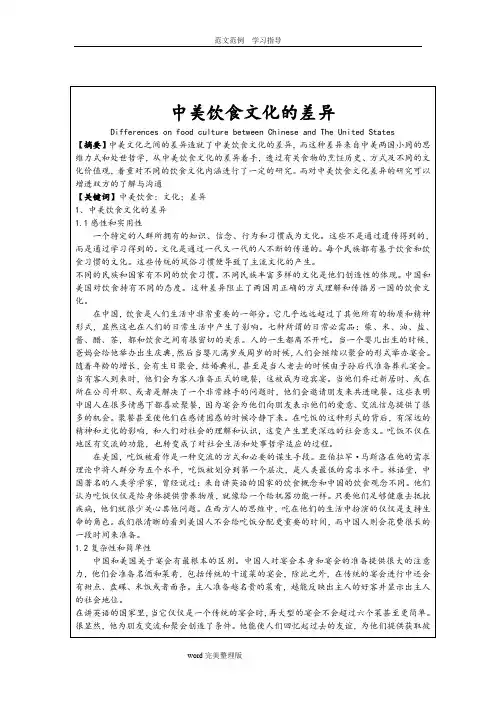

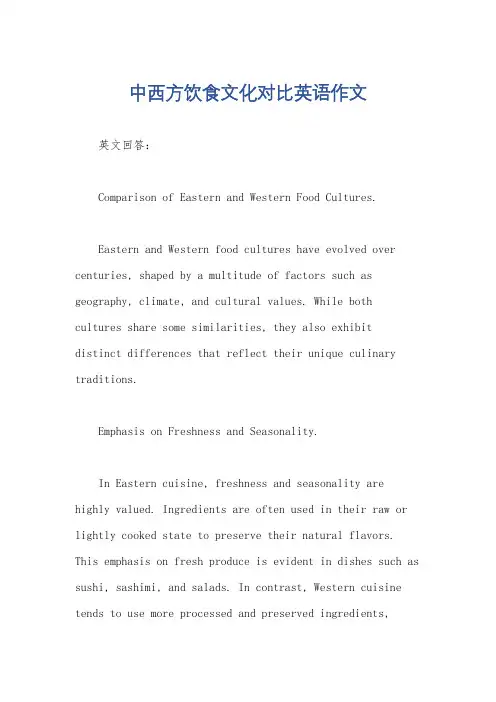
中西方饮食文化对比英语作文英文回答:Comparison of Eastern and Western Food Cultures.Eastern and Western food cultures have evolved over centuries, shaped by a multitude of factors such as geography, climate, and cultural values. While bothcultures share some similarities, they also exhibitdistinct differences that reflect their unique culinary traditions.Emphasis on Freshness and Seasonality.In Eastern cuisine, freshness and seasonality are highly valued. Ingredients are often used in their raw or lightly cooked state to preserve their natural flavors. This emphasis on fresh produce is evident in dishes such as sushi, sashimi, and salads. In contrast, Western cuisine tends to use more processed and preserved ingredients,allowing for greater flexibility in preparation and storage.Balance and Harmony.Eastern cuisine is characterized by a focus on balance and harmony. Dishes often combine a variety of flavors and textures, such as sweet, sour, salty, and bitter. This balance is achieved through the careful selection and combination of ingredients, as well as the use of cooking techniques that preserve the natural flavors of each ingredient. Western cuisine, on the other hand, often emphasizes a single dominant flavor, such as saltiness or sweetness, and may use more intense seasonings and sauces.Communal Dining.In Eastern cultures, dining is often a communal experience, with meals shared among family and friends. Dishes are typically served in large portions and placed in the center of the table, allowing everyone to partake. This communal aspect fosters a sense of togetherness and sharing. Western cuisine, while not always communal, often involvessmaller portion sizes and individual plates, reflecting a more individualized approach to dining.Influence of Religion.Religion has played a significant role in shaping both Eastern and Western food cultures. In the East, Buddhismand Taoism have influenced the development of vegetarianand vegan diets. Hinduism has also introduced a wide rangeof spices and herbs to Indian cuisine. In the West, Christianity has influenced fasting practices and dietary restrictions during Lent and other religious holidays.Availability of Ingredients.The availability of ingredients has also shaped the development of Eastern and Western food cultures. Eastern cuisine has long been influenced by the abundance of rice, vegetables, and seafood in Asia. Western cuisine, on the other hand, has historically relied on wheat, meat, anddairy products, which were more readily available in Europe.Impact of Globalization.Globalization has led to increased interaction and exchange between Eastern and Western food cultures. Ingredients, dishes, and culinary techniques from both cultures have become more widely available and incorporated into new and innovative cuisines. This has contributed to a greater appreciation and understanding of both Eastern and Western culinary traditions.中文回答:东西方饮食文化对比。
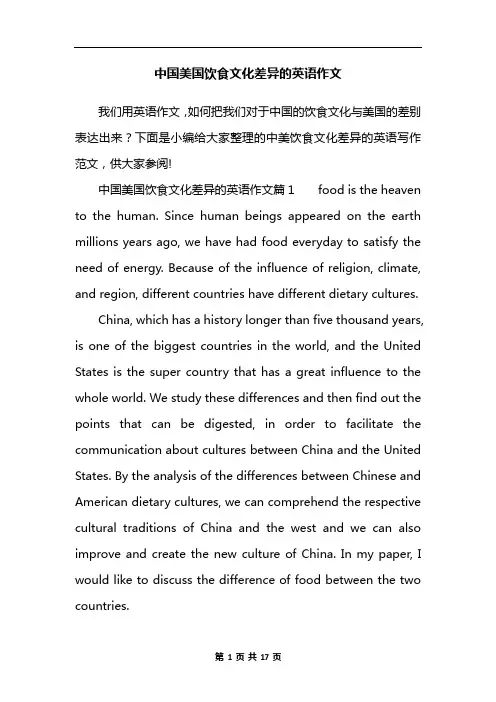
中国美国饮食文化差异的英语作文我们用英语作文,如何把我们对于中国的饮食文化与美国的差别表达出来?下面是小编给大家整理的中美饮食文化差异的英语写作范文,供大家参阅!中国美国饮食文化差异的英语作文篇1 food is the heaven to the human. Since human beings appeared on the earth millions years ago, we have had food everyday to satisfy the need of energy. Because of the influence of religion, climate, and region, different countries have different dietary cultures.China, which has a history longer than five thousand years, is one of the biggest countries in the world, and the United States is the super country that has a great influence to the whole world. We study these differences and then find out the points that can be digested, in order to facilitate the communication about cultures between China and the United States. By the analysis of the differences between Chinese and American dietary cultures, we can comprehend the respective cultural traditions of China and the west and we can also improve and create the new culture of China. In my paper, I would like to discuss the difference of food between the two countries.中国美国饮食文化差异的英语作文篇2 Hello , everyone we are very proud to introduce our topic . my name is huangxiaolong ,he is jiangzhihui ,he is lihuan .lets begin. Our topic is Differences Between Chinese And Western Food. cultural differences between East and West created a difference in food culture。
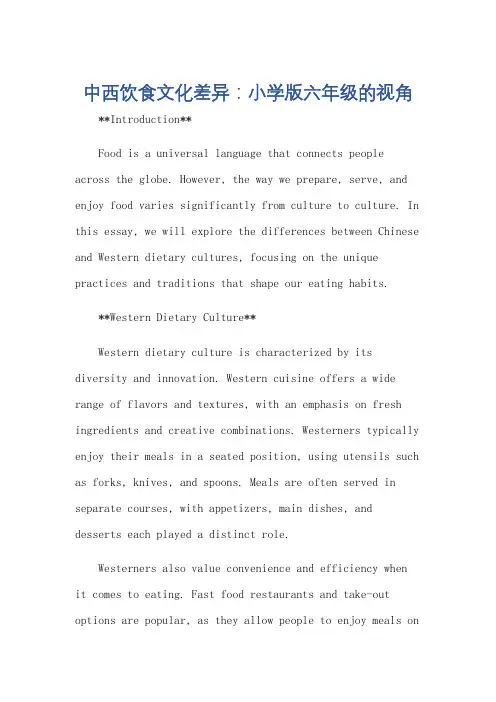
中西饮食文化差异:小学版六年级的视角 **Introduction**Food is a universal language that connects people across the globe. However, the way we prepare, serve, and enjoy food varies significantly from culture to culture. In this essay, we will explore the differences between Chinese and Western dietary cultures, focusing on the unique practices and traditions that shape our eating habits.**Western Dietary Culture**Western dietary culture is characterized by its diversity and innovation. Western cuisine offers a wide range of flavors and textures, with an emphasis on fresh ingredients and creative combinations. Westerners typically enjoy their meals in a seated position, using utensils such as forks, knives, and spoons. Meals are often served in separate courses, with appetizers, main dishes, and desserts each played a distinct role.Westerners also value convenience and efficiency when it comes to eating. Fast food restaurants and take-out options are popular, as they allow people to enjoy meals onthe go. Additionally, Westerners often prepare meals in advance, using recipes and cookbooks to ensure that their dishes turn out perfectly.**Chinese Dietary Culture**In contrast, Chinese dietary culture is known for its emphasis on balance and harmony. Chinese cuisine is based on the principles of Yin and Yang, which emphasize the importance of maintaining a harmonious balance between opposing forces. Foods are classified as either "hot" or "cold," and are combined in ways that promote balancewithin the body.Chinese meals are typically served as a communal experience, with everyone gathered around a table. Food is eaten with chopsticks, which require a certain amount of skill and coordination. Meals in China often consist of a variety of dishes, including rice, noodles, vegetables, and protein sources such as fish, chicken, or beef. Each dish is carefully prepared and presented, with an emphasis on both taste and presentation.**Conclusion**The differences between Chinese and Western dietary cultures are vast and fascinating. Western cuisine offers a diverse array of flavors and textures, while Chinesecuisine emphasizes balance and harmony. Both cultures have unique practices and traditions that shape our eating habits, and understanding these differences can help us appreciate the rich diversity of food cultures around the world.**中文翻译****中西饮食文化差异:小学版六年级的视角****引言**食物是一种世界性的语言,连接着全球各地的人们。
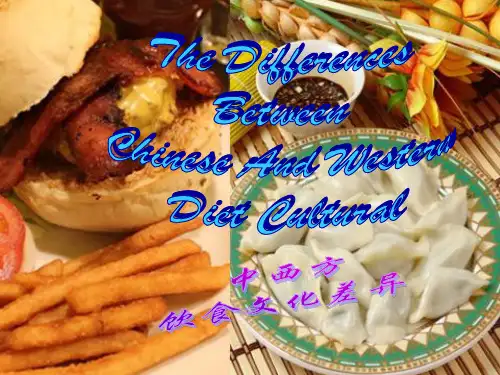
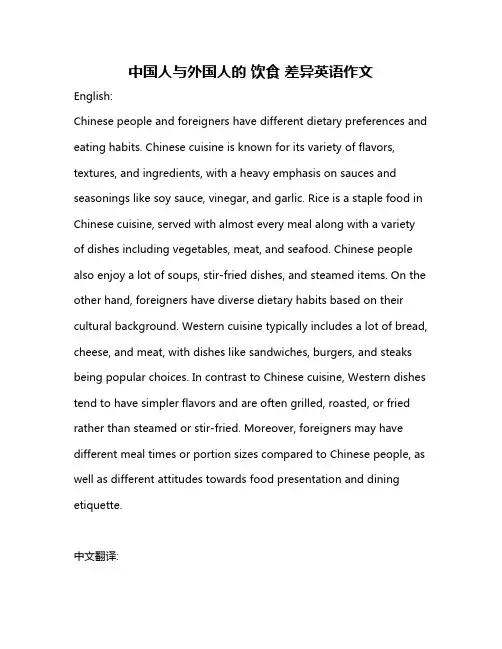
中国人与外国人的饮食差异英语作文English:Chinese people and foreigners have different dietary preferences and eating habits. Chinese cuisine is known for its variety of flavors, textures, and ingredients, with a heavy emphasis on sauces and seasonings like soy sauce, vinegar, and garlic. Rice is a staple food in Chinese cuisine, served with almost every meal along with a variety of dishes including vegetables, meat, and seafood. Chinese people also enjoy a lot of soups, stir-fried dishes, and steamed items. On the other hand, foreigners have diverse dietary habits based on their cultural background. Western cuisine typically includes a lot of bread, cheese, and meat, with dishes like sandwiches, burgers, and steaks being popular choices. In contrast to Chinese cuisine, Western dishes tend to have simpler flavors and are often grilled, roasted, or fried rather than steamed or stir-fried. Moreover, foreigners may have different meal times or portion sizes compared to Chinese people, as well as different attitudes towards food presentation and dining etiquette.中文翻译:中国人和外国人在饮食口味和习惯上有所不同。
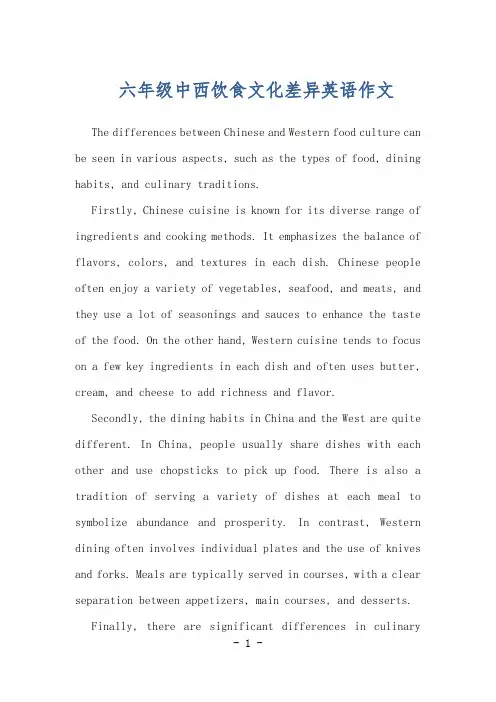
六年级中西饮食文化差异英语作文The differences between Chinese and Western food culture can be seen in various aspects, such as the types of food, dining habits, and culinary traditions.Firstly, Chinese cuisine is known for its diverse range of ingredients and cooking methods. It emphasizes the balance of flavors, colors, and textures in each dish. Chinese people often enjoy a variety of vegetables, seafood, and meats, and they use a lot of seasonings and sauces to enhance the taste of the food. On the other hand, Western cuisine tends to focus on a few key ingredients in each dish and often uses butter, cream, and cheese to add richness and flavor.Secondly, the dining habits in China and the West are quite different. In China, people usually share dishes with each other and use chopsticks to pick up food. There is also a tradition of serving a variety of dishes at each meal to symbolize abundance and prosperity. In contrast, Western dining often involves individual plates and the use of knives and forks. Meals are typically served in courses, with a clear separation between appetizers, main courses, and desserts.Finally, there are significant differences in culinarytraditions between China and the West. Chinese culinary traditions have a long history and are deeply rooted in the country's culture and customs. Many Chinese dishes are associated with specific festivals, such as dumplings during the Chinese New Year and mooncakes during the Mid-Autumn Festival. In the West, there is a strong emphasis on formal dining etiquette and the use of proper table manners, such as placing the napkin on the lap and using the correct utensils for each course.中西饮食文化的差异可以从食物类型、用餐习惯和烹饪传统等方面看出来。
中西方饮食差异英语短文There are significant differences between Western and Chinese diets. Western diets typically include a higher consumption of red meat, dairy products, processed foods, and sugar. On the other hand, Chinese diets are generally based on grains, vegetables, and protein sources like fish and tofu.Western diets tend to be more individualized, with each person having their own plate of food. In contrast, Chinese meals are often shared family-style, with dishes placed in the center of the table for everyone to serve themselves.In terms of cooking methods, Western cuisine often involves grilling, frying, or baking, which can result in a higher fat content. Chinese cuisine, on the other hand, commonly uses methods such as stir-frying, steaming, and boiling, which tend to be healthier.The concept of food presentation also differs between the two cultures. Western dishes focus on aesthetics and are often meticulously arranged on the plate. Chinese dishes, on the other hand, prioritize harmony and balance, with each ingredient having its own significance and meaning.These dietary differences can also be seen in the incidence of certain health conditions. Western diets have been linked to a higherrisk of obesity, heart disease, and Type 2 diabetes, while Chinese diets have been associated with lower rates of these conditions.In recent years, with increased globalization, there has been some convergence of diets between the Western and Chinese cultures. Western fast food chains have become popular in China, while Chinese food establishments have gained popularity in Western countries. However, traditional dietary patterns still hold strong in both cultures.In conclusion, the differences between Western and Chinese diets are mainly characterized by the types of foods consumed, cooking methods, meal structures, and cultural values towards food presentation. These differences contribute to variations in health outcomes and reflect the diverse eating habits of these two cultures.中西方饮食存在显著差异。
东西方饮食文化的差异英语作文四年级下册全文共3篇示例,供读者参考篇1Differences Between Eastern and Western Food CultureFood is an essential part of every culture, and each region has its own unique culinary traditions. The differences between Eastern and Western food cultures are especially distinct, as they reflect the diverse histories, beliefs, and lifestyles of the people in these regions.One of the major differences between Eastern and Western food culture is the types of ingredients that are commonly used. In Eastern cuisine, ingredients such as rice, soy sauce, noodles, and seafood are staples. These ingredients are used to create dishes that are savory, aromatic, and often spicy. In contrast, Western cuisine often includes ingredients such as wheat, dairy products, meat, and vegetables. Western dishes tend to be hearty, rich, and flavorful.Another key difference between Eastern and Western food culture is the way meals are served and consumed. In Eastern cultures, meals are often served family-style, with several dishesplaced on the table for everyone to share. This communal style of dining encourages a sense of unity and shared experiences among family members and friends. In Western cultures, meals are typically served in individual portions, and each person has their own plate of food. This style of dining emphasizes individual preferences and choices.The cooking techniques and methods in Eastern and Western food culture also differ. In Eastern cuisine, stir-frying, steaming, and boiling are common cooking methods that are used to preserve the natural flavors of the ingredients. In Western cuisine, baking, roasting, and grilling are more frequently used to enhance the flavors and textures of the dishes.Furthermore, the dining etiquette and customs in Eastern and Western food culture are distinct. In Eastern cultures, it is customary to use chopsticks as the primary utensil for eating, and it is considered impolite to leave food on the plate. In Western cultures, forks, knives, and spoons are the standard utensils, and it is acceptable to leave food on the plate if one is full.Additionally, the attitudes towards food and dining in Eastern and Western cultures differ. In Eastern cultures, food isoften viewed as a way to maintain health and balance in the body. Many Eastern cuisines are based on the principles of Traditional Chinese Medicine or Ayurveda, which emphasize the healing properties of food. In Western cultures, food is often seen as a source of pleasure and enjoyment, and many Western dishes are designed to be delicious and indulgent.In conclusion, the differences between Eastern and Western food cultures are significant and reflect the unique values, beliefs, and traditions of the people in these regions. By understanding and appreciating these differences, we can gain a deeper understanding of the rich diversity of culinary traditions around the world.篇2Differences in Eastern and Western Food CulturesFood is an important aspect of culture, and different regions of the world have their own unique food traditions. In this essay, we will explore some of the key differences between Eastern and Western food cultures.One of the main differences between Eastern and Western food cultures is the types of staple foods that are consumed. In Eastern cultures, such as in China and Japan, rice is typically themain staple food. Rice is eaten with almost every meal and is a key component of many dishes. In Western cultures, on the other hand, bread and potatoes are more commonly consumed as the main staple foods. Wheat-based products like bread and pasta are popular in countries like Italy and France, while potatoes are a staple in countries like Ireland and the United Kingdom.Another difference between Eastern and Western food cultures is the use of seasonings and flavorings. Eastern cuisines tend to be more subtle and delicate in their use of seasonings, with flavors like soy sauce, ginger, and garlic being commonly used. Western cuisines, on the other hand, often use more bold and intense flavors, with ingredients like cheese, butter, and herbs being popular choices for adding flavor to dishes.In terms of meal structure, Eastern and Western food cultures also differ. In Eastern cultures, meals are often shared family-style, with multiple dishes being served at once and everyone helping themselves to the dishes. In Western cultures, meals are typically served in courses, with appetizers, main courses, and desserts being served in a specific order.Additionally, the way food is prepared and cooked can vary between Eastern and Western food cultures. In Eastern cultures, methods like stir-frying, steaming, and boiling are commonlyused to cook dishes, while in Western cultures, methods like roasting, baking, and grilling are more popular.Finally, the social aspects of eating also differ between Eastern and Western food cultures. In Eastern cultures, meal times are seen as a time for family and community bonding, with meals often being enjoyed together with extended family members and friends. In Western cultures, meal times are often more individualistic, with people eating alone or with just a small group of friends or family members.In conclusion, while there are many differences between Eastern and Western food cultures, both have their own unique traditions and values when it comes to food and eating. By understanding and appreciating the diversity of food cultures around the world, we can gain a deeper appreciation for the role that food plays in shaping our identities and our cultures.篇3Differences in Eastern and Western Dietary CulturesFood plays a significant role in different cultures around the world. As a result, there are many differences between Eastern and Western dietary cultures. These differences are influenced by various factors such as geography, history, climate, religion, andtraditions. In this essay, we will explore some of the key differences between Eastern and Western dietary cultures.One of the most obvious differences between Eastern and Western dietary cultures is the types of staple foods that are consumed. In the East, rice is a staple food that is consumed in large quantities in countries like China, Japan, and India. Rice is usually served with a variety of dishes such as vegetables, meat, and seafood. In contrast, bread, pasta, and potatoes are the main staples in Western countries like the United States, Italy, and Germany.Another major difference between Eastern and Western dietary cultures is the way food is prepared and cooked. In the East, food is often stir-fried, steamed, or boiled. These cooking methods help to preserve the natural flavors and nutrients of the ingredients. On the other hand, Western cuisine often involves baking, roasting, grilling, or frying food. These methods can enhance the flavor of food but may also reduce its nutritional value.In terms of ingredients, Eastern and Western dietary cultures also differ significantly. Eastern cuisine relies heavily on fresh herbs, spices, and sauces to add flavor to dishes. Common ingredients in Eastern cuisine include soy sauce, ginger, garlic,and chili peppers. Western cuisine, on the other hand, often uses butter, cream, and cheese to add richness and flavor to dishes. Western dishes may also include a variety of herbs and spices, but they are generally used in smaller quantities.The way meals are structured and served is another key difference between Eastern and Western dietary cultures. In Eastern cultures, meals are often served family-style, with multiple dishes shared among diners. This encourages social interaction and promotes a sense of community. In contrast, Western cultures typically serve individual portions of food, with each person having their own plate. This allows for greater control over portion sizes and preferences.The concept of dessert also varies between Eastern and Western dietary cultures. In the East, desserts are generally light and not very sweet. Examples include fresh fruit, sweet soups, and mochi (a Japanese rice cake). In the West, desserts are often rich, indulgent, and sweet. Common Western desserts include cakes, pies, cookies, and ice cream. The difference in dessert preferences reflects the overall cultural attitudes towards sweetness and indulgence.Religion and beliefs also play a significant role in shaping Eastern and Western dietary cultures. In many Eastern countries,religious beliefs such as Buddhism, Hinduism, and Islam influence dietary practices. For example, Hindus do not consume beef, Muslims do not eat pork, and Buddhists follow a vegetarian diet. In the West, religious dietary restrictions are less common, but cultural beliefs and values still impact food choices. For example, many Westerners prioritize convenience, taste, and appearance when choosing what to eat.In conclusion, there are many differences between Eastern and Western dietary cultures. These differences are shaped by factors such as staple foods, cooking methods, ingredients, meal structure, dessert preferences, and religious beliefs. While Eastern and Western cuisines may seem very different, they both reflect the unique histories, traditions, and values of their respective cultures. By understanding and appreciating these differences, we can gain a deeper appreciation for the diversity and richness of global food cultures.。
中西方饮食文化对比英语作文英文回答:In terms of diet culture, there are some notable differences between the East and the West. For example, in Western countries, people often have a big breakfast with eggs, bacon, and toast, while in China, a typical breakfast might consist of congee or steamed buns. Another difference is the use of utensils in the West, people use knives and forks to eat, while in China, chopsticks are the primary eating utensils. Additionally, the concept of dessert varies greatly between the two cultures. In the West, dessert is often a sweet dish like cake or ice cream, whereas in China, it may be something less sweet, like fruit.中文回答:就饮食文化而言,东西方之间存在一些显著的差异。
例如,在西方国家,人们通常会吃大份的早餐,如鸡蛋、培根和土司,而在中国,典型的早餐可能包括粥或包子。
另一个不同之处在于餐具的使用——在西方,人们用刀叉进餐,而在中国,筷子是主要的餐具。
此外,甜点的概念在两种文化中也存在很大差异。
在西方,甜点通常是像蛋糕或冰淇淋这样的甜食,而在中国,甜点可能会是一些不那么甜的食物,比如水果。